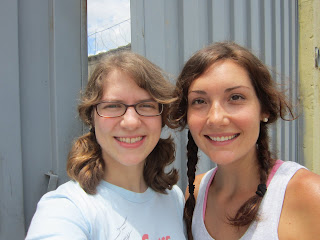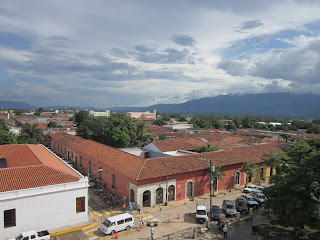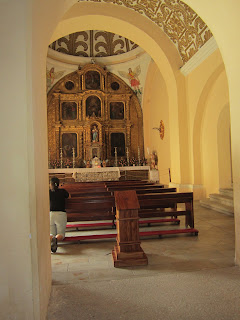Our trip began at 6:30am Sunday morning (it was almost a 12 hour drive one way). Five of us piled into Michelle's SUV, and we left Managua for Comayagua, Honduras. We crossed the border very easily (later we found out it also illegally) around 10, and one of the first differences we noticed about Honduras was that roads signs were a lot more common here.
Honduras is so beautiful! The whole drive was through green mountains like these.
After Tegucigalpa, we hit construction traffic. We were expecting it, so it wasn't too much of a bummer. Another surprise in Honduras were the pine forests that covered the mountains. Sometimes I felt like I was in Colorado, not Central America!
There aren't many rules on the roads in Central America. Probably because of this, there are a lot of monuments like this one that line the roads in memory of someone killed in an accident.
Our hotel was very comfortable. This is the view of Comayagua from the doorway of our room on the second floor.
On Monday night, we had dinner at a little restaurant beside this church in the Parque Central. With me beside the fountain is Jennifer, who has worked at Tesoros since it began and came along to see how a different school worked with special needs kids.
The purpose of our trip was to come to CasAyuda (House of Help). Michelle was asked by a special needs school in the states to act as liason with CasAyuda. While here, she planned to observe classes, answer teachers' questions, and give feedback on what she saw.
Here is the school. On the near right is the dormitory (some kids travel so far to come here, they have to stay the whole week), a painting workshop, and a bakery. The building on the far right houses the classrooms for children with cognitive impairments, and across the courtyard on the left are classrooms for deaf students and the cafeteria.
Some of the deaf students in the court for recess.
This is the preschool room where I spent most of my time. The kids are divided by mental capability, not by age, so the kids in preschool were anywhere from 3 to 19 years old. There was almost no organization in this room, and the kids were crazy! None of us could imagine working here every day.
Classes end at 12 every day, but after lunch, there are vocational classes for the deaf kids. We looked in on their painting class one day and were blown away by their talent! Apparently, a lot of them have natural talent that only needs encouragement. This paintings are given to volunteers as thank-yous, and sometimes sold to support the school and the children themselves.
Besides painting, the students also work with pottery, a printing press (I think that's what it's called -- something arty like that), and help in the bakery.
A reporter who wants to help the school with publicity came and interviewed Michelle on camera! We forgot to watch the news to see if we made it on...
Michelle, Jennifer, and Kate (a friend of Michelle's who is also a teacher) pose with all the teachers from the school.
Krista is a volunteer at another school near Managua. She came along with us in order to fulfill her life-long dream of visiting Honduras. It was really great to have her with us -- she was always excited about something!
Who knew they had lion's clubs in Central America?
Here's the church again. Some of the teachers took us site-seeing after class on Wednesday, so we got a closer look.
Here we are going up the staircase to the clock tower of the Church.
This clock is the oldest working clock in all of Central America, and possibly the world! It was built in 1450, at the latest (they think it might have been built in 1100) and was brought to Honduras in the 1600s. We got to see it strike the quarter hour -- very cool =)
Here is the view from the bell tower. Comayagua was once the capital of Honduras, and I think the guide said that the building you see here was one of the government buildings from that time period.
Another view of Comayagua and the mountains that surround it. In general, Honduras was much cleaner than Nicaragua, which makes sense as Nicaragua is the second poorest country in the Western Hemisphere (after Hati) and minimum wage in Honduras is twice that of Nicaragua.
A woman prays in the chapel inside the church.
Kate checks out the sweet peek-hole on the door of the Archaeological Museum.
Here is an example of the native dress of the people that once lived in the area that is now Comayagua. The man in the blue is Mario. He studied engineering, but now works at the school with the deaf students. He acted as our tour guide for the day.
The bell tower of the church from the streets of Comayagua
Next we went to the Atolera Joselyn, which is a little restaurant that only serves things made from corn. Atol is actually a sweet drink made from cooking corn mush and milk. Here are some of what we had -- tamales and fritas, both made from sweet corn dough and topped with sweet cream. Yummy!
On the way there and back, we went through Tegucigalpa, the capital of Honduras. Teguc (as the locals call it) is sprawled among the mountains and the scenery there is very pretty.
A look at Teguc -- street level. There are more western stores and restaurants in Teguc, than in Managua, and the traffic wasn't quite as crazy either.
Finally we arrived in Nicaragua once again! This is a picture of the mountainous north country, where many Nicaraguans farm.
All in all, it was a great trip. I learned a lot from listening to Kate and Michelle discuss the strengths and weaknesses of the classrooms at CasAyuda, and I loved encountering another part of God's creation. In your prayers this week, please remember the students and staff at CasAyuda. The teachers have a love for the kids, but sometimes lack the knowledge to teach them effectively. Pray that God would give them the perseverance to continue to learn. Also, CasAyuda has had to cut jobs recently, and the really need all the help they can get. They get lots of funding from the states, but the money is rarely given towards salaries. Pray that donors would realize that good teachers are more important than buildings and would be moved to give in a way that allows CasAyuda to hire the help they need.















































